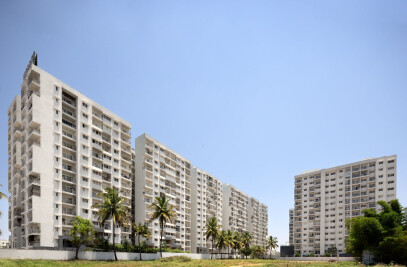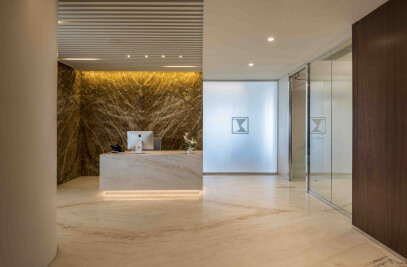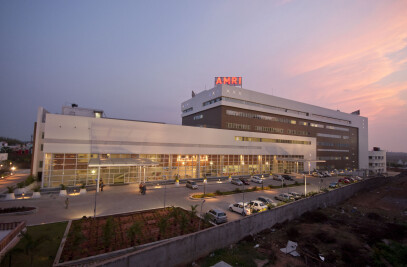Guntur city is a center for learning and is the administrative capital of Guntur District. Guntur’s significance as a hub for an industrialized center in India is rapidly growing and reinforced by its association with ILTD. In line with I.T.C.’s vision and mission which encompasses multiplicity, diversity and the pursuit of excellence, the I.L.T.D., Guntur campus master plan is conceived to accommodate this evolving image and to help transform the development into a growing business destination and a high performance residential campus.
As per the description of the client's brief, the master plan should help address ITC’s global vision by transforming the site within a sustainable framework into a high performance business campus. The key principles for the master plan were to create a transformation of the developemnt into a growing business destination, improvement in the pedestrian linkages and employ a basic principle of - work, live, play environment and thus, ensuring a flexibility in the plan to respond to changing market requirements.
The design approach for the campus Master plan includes environmental sustainability & better quality of life to the users as key principles for the current and future development. The proposed development is intended to functionally segregate the parcels into a corporate and a residential zone and to provide growth opportunities, in terms of land-use and increased employee numbers. The overall design is integrated using the concept of 6 ‘C’s as the guiding principles: Context, Creativity, Cohesiveness, Comprehensiveness, Climate and Community. The development is to allow for optimum and efficient utilization of quality real estate space by ITC for own use.
Guntur, being a hot and humid region, dictated the need for effective cooling strategies for both enclosed spaces and outdoor experiences. It was addressed through master planning strategies such as building orientation, compact planning, introduction of courtyards for cross ventilation and passive cooling techniques.
In order to accentuate the spectrum of design at the master planning level, large green cover space is introduced at the master planning level, thus improving the microclimate. Pedestrian and vehicular network may or may not be segregated and streets are shaded with trees, pergolas and/or canopies.
The soil conditions are excellent for farming and the water table in the region is quite high. Hence, a combination of wells/tanks supplying water by means of canals is adopted for irrigation of farming and landscape. Rainfall in the region is unpredictable. Hence, catchment areas are camouflaged within the landscape, so as to take care of drought conditions as well.
Within the site, houses have a rectangular plan aligned along the North - South axis with entrance facing the South. The closely built East and West compound walls shade the houses on each side in the morning and evening. At the building design level, cross-ventilation is ensured and west facing glazing is minimized or eliminated to reduce summer and fall afternoon heat gains.
Taking inspiration from the local architecture of Guntur, a courtyard typology has been specially developed to suit high rise buildings. A central courtyard planned between the units helps to mutually shade the walls and improves the microclimate by virtue of stack effect. Buffer zones around all the key living spaces help in reducing the direct heat gain.
All apartments have at least 2 sides opened to allow efficient cross ventilation. The units in the buildings are planned on each floor of G+8 apartment. These units are clustered together and oriented towards north and south (longer sides) in order to reduce the solar exposure and thus the external heat gain. Four units on each floor form a single bay unit helping free air movement.
The central courtyard planned between these single bay units help to mutually shade the walls of the apartment and also, to retain the existing trees on site. The position of the buildings is such that wind is funnelled from the Southwest towards the Northeast, cooling the open spaces. The units on each floor form a single bay enhancing free air movement though floor plates.
Shading devices are provided for the East, West and South facades and thick walls to facilitate insulation. The flooring is done in locally available cuddapah stone tiles. Sandy planters with light vegetation in the area between compound wall and the house help in absorbing heat and minimize the solar radiation. Also, deep-set balconies and low window to wall ratio, ensure greater levels of human comfort in such extreme climatic conditions for the residents. Jaalis were used as part of the design to allow flow of wind and light, as against an opaque drop pardi.
There are benches between every two adjacent gates of the house, which are used by the family members in the evenings to sit and chat with the neighbours. These benches are made of cuddapah stone tiles. The terraces are important spaces for house-hold and daily activities. The intermediate terraces are shared between 6 apartments and are envisaged to function as social gathering spaces. By incorporating the courtyards, thermal comfort is achieved to enjoy a pleasant temperature year-round while minimizing energy consumption and visual comfort to benefit from natural lighting for habitat that is pleasant to live in and aesthetically pleasing.
The design evolved around considering the possibility of the entire site being a green landscape from which development is then derived according to the requirement. The preservation of the existing green fabric, addition of place- making features and using the land for the productivity of the users form the basis of the landscape strategy. This allows many of the occupants to view a large foreground of green space that is treated with the native vegetation of the region and seasonal in character benefitting not only the ecology of the site but also the visual and physical sensibilities of the occupants. The central green spaces act as the primary lung structured around the shade providing trees as a response to the climate of the place but also with flowering and fruit bearing trees for visual aesthetics. The catchment areas were camouflaged within the landscape, so as to take care of drought conditions as well.
Planned on the ideology of ‘walk to work’, the development aims to improve the human efficiency and quality of life. A more cohesive approach is taken so that one’s carbon footprint can be reduced by virtue of design as well as lifestyle modifications and for the same ITC Limited as a company is committed to. Through conscious efforts towards energy reduction, sensitive water usage and promoting healthier lifestyle choices, the ILTD campus stands as benchmark for sustainable living contributing positively towards the health and performance of not only its residents but the regional community at large.






















































